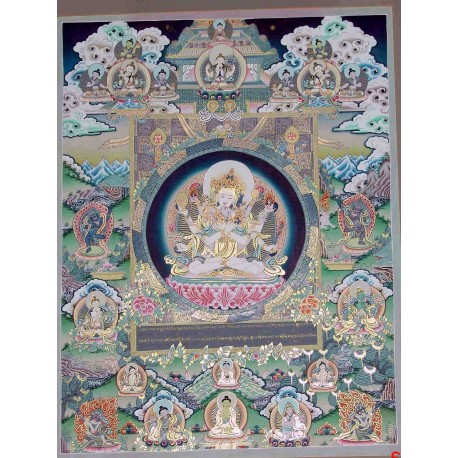No products
- English
- Ελληνικά
 View larger
View larger
- Remove this product from my favorite's list.
- Add this product to my list of favorites.
Guhyasamaja Akshobhyavajra Thangka
New product
1 Item
Warning: Last items in stock!
Guhyasamaja Akshobhyavajra
The painting portrays the figure of Guhyasamaja Akshobhyavajra in secret union with his consort Sparshavajra or Adhiprajna.
Guhyasamaja is seated in vajrasana (his legs crossed) on a double lotusthrone and is depicted with three heads and six arms. His prajna has an identical number of heads and arms; she is portrayed in sexual embrace around her partner, two of her most raised hands around his neck and with her legs around his hip. On their heads they wear crowns, the central leaf bearing a wheel of law, and their hair being tied up into a high chignon, topped by a cintamani (flaming pearl). The sign of illumination (the urna) is depicted on all six heads. The male god has flowers sticking out just above his ears. Both deity’s are adorned with earrings, necklaces, bracelets, anklets, skirts, shawls, girdles of pearls and ornaments. Although the two gods are complementary they both have an identical number of arms, legs and heads as well as similar attributes. Guhyasamaja’s hands are crossed in front of his chest holding a vajra (thunderbolt) and a ghanta (bell with vajra handle). His right hands hold a padma (lotusflower and symbol of purity and spiritual elevation) and a cakra (the wheel of the Buddhist law). His left hands hold a khadga (sword protecting wisdom) and a cintamani (a flaming pearl). The original gilded seal is beautifully engraved with a vishvavajra, symbol of the four cardinal points of the universe.
In the center of the painting, Guhyasamaja Akshobhyavajra is white. Here, the jina Buddha Akshobhya is specifically represented as Guhyasamaja. Akshobhya is specifically located in the east, but in this instance, he is placed in the center of the mandala for reasons which will be discussed below. Irrespective of his position, Guhyasamaja Akshobhyavajra has three heads and embraces his Prajna. His right head is white and his left head is red. He has a total of six arms that hold various attributes: Starting on his proper right, from top to bottom, Guhyasamaja Akshobhyavajra holds a chakra or wheel, padma or lotus, and a vajra or adamantine scepter in these hands. From top to bottom on his left side, he holds a kadgha or sword, triratna or three jewels, and a ghanta or bell in these hands. His two principle hands, crossed near the center of his body, hold the vajra and ghanta. Each attribute represents and symbolizes a specific kula, or lineage or family of each Buddha; these attributes simply rotate from hand to hand when a different Buddha is depicted in the central position. Further, it is the proper right principle hand that holds the attribute particular to each kula Buddha, while the attribute in the proper left principle hand remains constant in this mandala. Here, for example, the vajra is the kula symbol for the Buddha Akshobhya and Guhyasamaja, and the ghanta remains a constant. Moreover, it is the vajra that "appears to rotate in the hands of the deities, thereby also altering the positions of the other attributes. Each [j]ina Buddha carries all five symbols, thus underscoring their interdependence and their identity as a whole" (S. Huntington & J. Huntington, 192).
The other half of this central paired-deity is Sparshavajra. She is light blue and also has a total of six arms; the two hands that are encircled around Guhyasamaja Akshobhyavajra's neck cannot be seen, but they are holding a chakra and kadgha in her right and left hands, respectively. The remaining right hands of Sparshavajri hold a sword and a jewel, while those on her left carry a wheel and a lotus. Visually, the attributes of these two central deities are reflective of the other.
Guhyasamaja, associated with the Buddha Akshobhya, is the most ancient and fundamental Tantra of Vajrayana tradition of Buddhism. Padmavajra in his work Guhyasiddhi cites it under the name of Shrisamaja as the most authoritative. In this all the components of the Five Tathagatas, mudra, kula, prajna, their colours and directions, form and meaning were clearly systematized.










